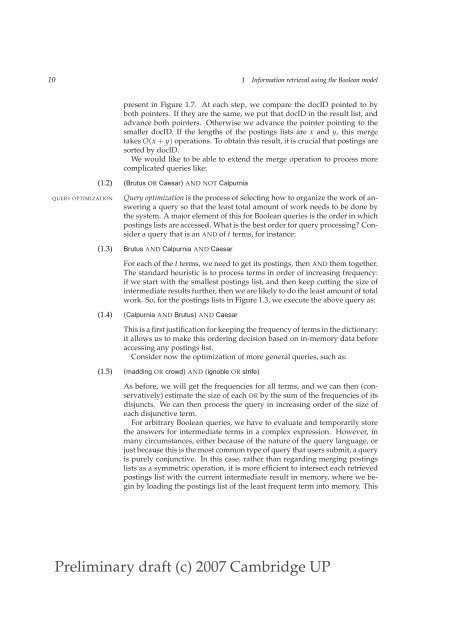Preliminary draft (c) 2007 Cambridge UP - Villanova University
Preliminary draft (c) 2007 Cambridge UP - Villanova University
Preliminary draft (c) 2007 Cambridge UP - Villanova University
Create successful ePaper yourself
Turn your PDF publications into a flip-book with our unique Google optimized e-Paper software.
10 1 Information retrieval using the Boolean model<br />
present in Figure 1.7. At each step, we compare the docID pointed to by<br />
both pointers. If they are the same, we put that docID in the result list, and<br />
advance both pointers. Otherwise we advance the pointer pointing to the<br />
smaller docID. If the lengths of the postings lists are x and y, this merge<br />
takes O(x + y) operations. To obtain this result, it is crucial that postings are<br />
sorted by docID.<br />
We would like to be able to extend the merge operation to process more<br />
complicated queries like:<br />
(1.2) (Brutus OR Caesar) AND NOT Calpurnia<br />
QUERY OPTIMIZATION<br />
Query optimization is the process of selecting how to organize the work of answering<br />
a query so that the least total amount of work needs to be done by<br />
the system. A major element of this for Boolean queries is the order in which<br />
postings lists are accessed. What is the best order for query processing? Consider<br />
a query that is an AND of t terms, for instance:<br />
(1.3) Brutus AND Calpurnia AND Caesar<br />
For each of the t terms, we need to get its postings, then AND them together.<br />
The standard heuristic is to process terms in order of increasing frequency:<br />
if we start with the smallest postings list, and then keep cutting the size of<br />
intermediate results further, then we are likely to do the least amount of total<br />
work. So, for the postings lists in Figure 1.3, we execute the above query as:<br />
(1.4) (Calpurnia AND Brutus) AND Caesar<br />
This is a first justification for keeping the frequency of terms in the dictionary:<br />
it allows us to make this ordering decision based on in-memory data before<br />
accessing any postings list.<br />
Consider now the optimization of more general queries, such as:<br />
(1.5) (madding OR crowd) AND (ignoble OR strife)<br />
As before, we will get the frequencies for all terms, and we can then (conservatively)<br />
estimate the size of each OR by the sum of the frequencies of its<br />
disjuncts. We can then process the query in increasing order of the size of<br />
each disjunctive term.<br />
For arbitrary Boolean queries, we have to evaluate and temporarily store<br />
the answers for intermediate terms in a complex expression. However, in<br />
many circumstances, either because of the nature of the query language, or<br />
just because this is the most common type of query that users submit, a query<br />
is purely conjunctive. In this case, rather than regarding merging postings<br />
lists as a symmetric operation, it is more efficient to intersect each retrieved<br />
postings list with the current intermediate result in memory, where we begin<br />
by loading the postings list of the least frequent term into memory. This<br />
<strong>Preliminary</strong> <strong>draft</strong> (c)<strong>2007</strong> <strong>Cambridge</strong> <strong>UP</strong>



